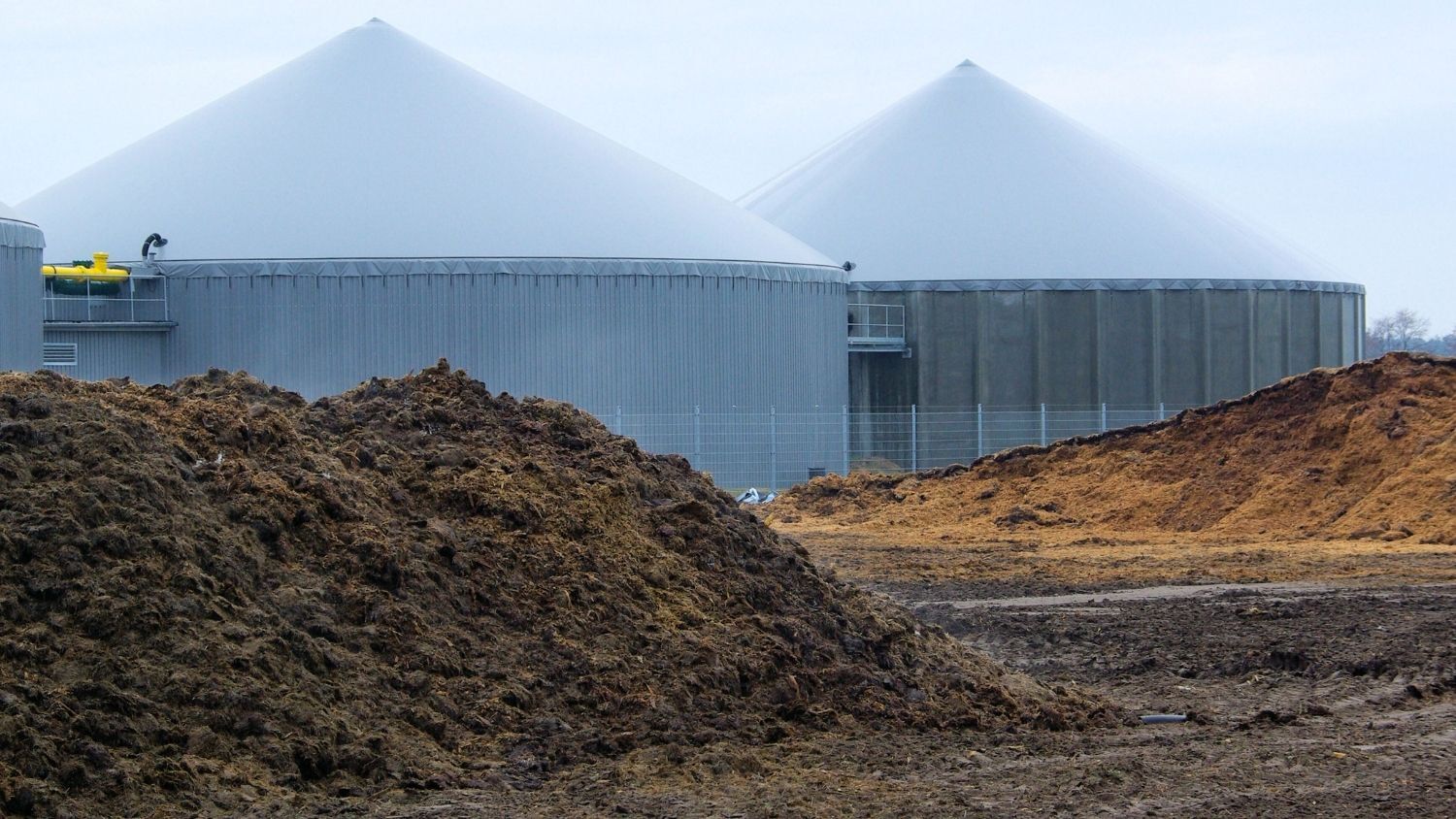While 2020 sure wasn't an easy year, we too had our ups and downs. Read more in our quarterly newsletter.
Growing further
 In our last newsletter, we mentioned how we grew in 2020. This year is no different, and we already welcomed Serge Niederkorn, our new CEO as of March 2021. Serge has a background in growing startups and is a valuable addition to our team.
In our last newsletter, we mentioned how we grew in 2020. This year is no different, and we already welcomed Serge Niederkorn, our new CEO as of March 2021. Serge has a background in growing startups and is a valuable addition to our team.
Daniel Steitz, our founder and former CEO, will get back into our projects and use his expertise and knowhow as Chief Innovation Officer. He will strengthen our development team, that is building innovative solutions - for our partners as well as for novoMOF.
P.s.: we are looking for new team members: Job openings at novoMOF
Finished construction and start of setup
The construction work within our production space is complete and we are looking forward to putting the additional space to use - mainly for further equipment in the production and shaping line.
From our blog
New articles of the last quarter
 Energy-efficient CO2 capture and release using magnetic materials
Energy-efficient CO2 capture and release using magnetic materials
Are magnetic materials the key to reducing carbon emissions in the future?
Converting CO2 into fuels
Besides complete removal from the atmosphere, recycling CO2 into fuels could offer an alternative to other energy sources
 Highly porous materials for gaseous fuels storage
Highly porous materials for gaseous fuels storage
Besides the separation from gas streams, adsorption storage using MOFs could increase the range of gas-driven vehicles of the future.
Interesting news & publications
Preparing for the future carbon economy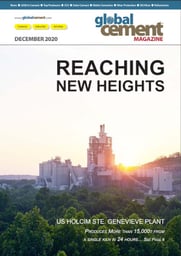
A very promising message comes GlobalCement on a project between LaFargeHolcim and Svante, that will operate the world's first CO2 emission reduction based metal-organic frameworks! During the project CO2ment, a consortium of companies has proven that metal-organic frameworks can be applied to separate carbon dioxide from flue gas streams in an economic manner. The plan is to capture 2 Mt of CO2 per year from just a single plant, while more will follow in the next years.
Click the picture to get to the report:
25 years of Reticular Chemistry
At its core, reticular chemistry has translated the precision and expertise of organic and inorganic synthesis to the solid state. While initial excitement over metal‐organic frameworks (MOFs) and covalent organic frameworks (COFs) was undoubtedly fueled by their unprecedented porosity and surface areas, the most profound scientific innovation of the field has been the elaboration of design strategies for the synthesis of extended crystalline solids through strong directional bonds. In this contribution we highlight the different classes of reticular materials that have been developed, how these frameworks can be functionalized and how complexity can be introduced into their backbones. Finally, we show how the structural control over these materials is being extended from the molecular scale to their crystal morphology and shape on the nanoscale, all the way to their shaping on the bulk scale.
Click the picture to find out more.
Publications by our scientific advisors
Reticular Chemistry and Harvesting Water from Desert Air
 Although chemists in general are concerned with the art and science of constructing molecules and understanding their behavior, for a long time the idea that such molecules can be linked together by strong bonds to make infinite, extended structures was fraught with failure. The notion of using molecular building blocks to make such structures invariably led to chaotic, ill-defined materials and therefore not only defying the chemists’ need to exert their will on the design of matter but also preventing them from deciphering the atomic arrangement of such products. The field remained undeveloped for most of the twentieth century, and it was taken as an article of faith that linking molecules by strong bonds to make extended structures is a “waste of time” because “it doesn’t work.”
Although chemists in general are concerned with the art and science of constructing molecules and understanding their behavior, for a long time the idea that such molecules can be linked together by strong bonds to make infinite, extended structures was fraught with failure. The notion of using molecular building blocks to make such structures invariably led to chaotic, ill-defined materials and therefore not only defying the chemists’ need to exert their will on the design of matter but also preventing them from deciphering the atomic arrangement of such products. The field remained undeveloped for most of the twentieth century, and it was taken as an article of faith that linking molecules by strong bonds to make extended structures is a “waste of time” because “it doesn’t work.”
Read more about the chronological development of the water harvesting device (latest prototype yielding 4l per day!)
In situ X‐ray Diffraction Investigation of the Crystallisation of Perfluorinated Ce(IV)‐based Metal‐Organic Frameworks with UiO‐66 and MIL‐140 architectures
Stephen J. I. Shearan, Jannick Jacobsen, Prof. Ferdinando Costantino, Dr. Roberto D'Amato, Dr. Dmitri Novikov, Prof. Norbert Stock, Prof. Enrico Andreoli, Dr. Marco Taddei
We report on the results of an in situ synchrotron powder X‐ray diffraction study of the crystallisation in aqueous medium of two recently discovered perfluorinated CeIV‐based metal–organic frameworks (MOFs), analogues of the already well investigated ZrIV‐based UiO‐66 and MIL‐140A, namely, F4_UiO‐66(Ce) and F4_MIL‐140A(Ce). The two MOFs were originally obtained in pure form in similar conditions, using ammonium cerium nitrate and tetrafluoroterephthalic acid as reagents, and small variations of the reaction parameters were found to yield mixed phases. Here, we investigate the crystallisation of these compounds, varying parameters such as temperature, amount of the protonation modulator nitric acid and amount of the coordination modulator acetic acid.
An Investigation into the Intrinsic Peroxidase‐Like Activity of Fe‐MOFs and Fe‐MOFs/Polymer Composites
 Bhawana Thakur, Vikram V. Karve, Daniel T. Sun, A. Lisa Semrau, Lennart J. K. Weiß, Leroy Grob, Roland A. Fischer, Wendy L. Queen, Bernhard Wolfrum
Bhawana Thakur, Vikram V. Karve, Daniel T. Sun, A. Lisa Semrau, Lennart J. K. Weiß, Leroy Grob, Roland A. Fischer, Wendy L. Queen, Bernhard Wolfrum
The quest for developing materials that provide a perfect trade‐off between factors such as enzyme‐like response, stability, and low cost has been a long‐standing challenge in the field of biosensing. Metal‐organic frameworks (MOFs) and their composites have emerged as promising candidates for biosensing applications due to their exceptional properties such as tunable pore size, high specific surface area, and exposed active sites. A comparative study of the intrinsic peroxidase‐like activity of five different MOF materials: Fe‐BTC, NH2‐MIL‐101(Fe), composites of Fe‐BTC with polymers polydopamine (PDA), poly p‐phenylenediamine (PpPDA), and poly(3,4‐ethylenedioxythiophene) is reported for the detection of H2O2, an important biomarker in biomedical diagnostics. The response of these materials toward H2O2 via electrochemical and colorimetric techniques is mapped and it is found that, at neutral pH, the Fe‐BTC/PEDOT composite exhibits the highest sensitivity and activity compared to other MOF materials in this study. The results indicate that the combination of unique properties of Fe‐BTC and conducting polymer PEDOT, improves the peroxidase‐like activity of the Fe‐BTC/PEDOT composite compared to the individual components. This work presents a new opportunity for easy‐to synthesize and low‐cost MOFs/conducting polymer composites for biosensing applications and provides significant insights to achieve rational design of composites with desirable functional properties.
Synergistic material and process development: Application of a metal-organic framework, Cu-TDPAT, in single-cycle hydrogen purification and CO2 capture from synthesis gas
Mehrdad Asgaria, Anne Strebb, Mijndert van der Spek, Wendy Queen, Marco Mazzotti
We employ a synergistic material and process development strategy to improve the performance of a single-cycle vacuum pressure swing adsorption (VPSA) process for the hydrogen purification and the CO2 separation from reforming-based hydrogen synthesis. Based on process-informed adsorbent selection criteria, including high CO2 cyclic capacity and selective uptake of impurities like CO, N2, and CH4 over H2, a metal organic framework (MOF), Cu-TDPAT, is selected. First, adsorption isotherms of CO2, CO, CH4, N2 and H2 are measured. Subsequently, a column model is used for optimization-based analysis of the VPSA cycle with Cu-TDPAT as the adsorbent to assess both the separation performance, and the process performance in terms of energy consumption and productivity.
Spatio‐Chemical Heterogeneity of Defect‐Engineered Metal–Organic Framework Crystals Revealed by Full‐Field Tomographic X‐ray Absorption Spectroscopy
 Dr. Dario Ferreira Sanchez, Dr. Johannes Ihli, Damin Zhang, Thomas Rohrbach, Dr. Patric Zimmermann, Dr. Jinhee Lee, Dr. Camelia N. Borca, Natascha Böhlen, Dr. Daniel Grolimund, Prof. Dr. Jeroen A. van Bokhoven, Dr. Marco Ranocchiari
Dr. Dario Ferreira Sanchez, Dr. Johannes Ihli, Damin Zhang, Thomas Rohrbach, Dr. Patric Zimmermann, Dr. Jinhee Lee, Dr. Camelia N. Borca, Natascha Böhlen, Dr. Daniel Grolimund, Prof. Dr. Jeroen A. van Bokhoven, Dr. Marco Ranocchiari
The introduction of structural defects in metal–organic frameworks (MOFs), often achieved through the fractional use of defective linkers, is emerging as a means to refine the properties of existing MOFs. These linkers, missing coordination fragments, create unsaturated framework nodes that may alter the properties of the MOF. A property‐targeted utilization of this approach demands an understanding of the structure of the defect‐engineered MOF. We demonstrate that full‐field X‐ray absorption near‐edge structure computed tomography can help to improve our understanding. This was demonstrated by visualizing the chemical heterogeneity found in defect‐engineered HKUST‐1 MOF crystals. A non‐uniform incorporation and zonation of the defective linker was discovered, leading to the presence of clusters of a second coordination polymer within HKUST‐1. The former is suggested to be responsible, in part, for altered MOF properties; thereby, advocating for a spatio‐chemically resolved characterization of MOFs.
Rapidly Reversible Organic Crystalline Switch for Conversion of Heat into Mechanical Energy
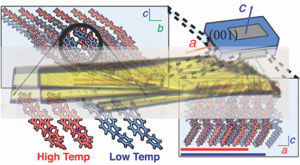 Dharmarwardana, S. Pakhira, R. P. Welch, C. C. Narvaez, M. A. Luzuriaga, B. S. Arimilli, G. T. McCandless, B. Fahimi, J. Mendoza-Cortes, J. J. Gassensmith
Dharmarwardana, S. Pakhira, R. P. Welch, C. C. Narvaez, M. A. Luzuriaga, B. S. Arimilli, G. T. McCandless, B. Fahimi, J. Mendoza-Cortes, J. J. GassensmithSolid-state thermoelasticbehavior—a sudden exertion of an expansive or contractive physical force following a temperature changeand phase transition in a solid-statecompound—is rarein organic crystals, few are reversible systems, and most of these are limited to a dozen or so cycles before the crystal degrades or they reverse slowly over the course of many minutes or even hours. Comparableto thermosalience, wherein crystal phase changes induce energetic jumping, thermomorphism produces physical workvia consistent andnear-instantaneouspredictable directional force.In this work, we show afully reversible thermomorphicactuator that is stable at room temperature for multiple years and is capable of actuation for more than two hundred cyclesat near ambient temperature. Specifically, the crystals shrink to 90% of theiroriginal length instantaneously upon heating beyond 45 °C and expand back to theiroriginal length upon cooling below 35 °C. Furthermore, the phase transition occurs instantaneously, with little obvious hysteresis, allowing us to create real-time actuating thermal fuses that cycle between on and off rapidly.
High-Capacitance Pseudocapacitors from Li+ Ion Intercalation in Nonporous, Electrically Conductive 2D Coordination Polymers
 Harish Banda, Jin-Hu Dou, Tianyang Chen, Nicole J. Libretto, Madhusudan Chaudhary, Guy M. Bernard, Jeffrey T. Miller, Vladimir K. Michaelis, and Mircea Dincă
Harish Banda, Jin-Hu Dou, Tianyang Chen, Nicole J. Libretto, Madhusudan Chaudhary, Guy M. Bernard, Jeffrey T. Miller, Vladimir K. Michaelis, and Mircea Dincă
Electrochemical capacitors (ECs) have emerged as reliable and fast-charging electrochemical energy storage devices that offer high power densities. Their use is still limited, nevertheless, by their relatively low energy density. Because high specific surface area and electrical conductivity are widely seen as key metrics for improving the energy density and overall performance of ECs, materials that have excellent electrical conductivities but are otherwise nonporous, such as coordination polymers (CPs), are often overlooked. Here, we report a new nonporous CP, Ni3(benzenehexathiolate) (Ni3BHT), which exhibits high electrical conductivity of over 500 S/m. When used as an electrode, Ni3BHT delivers excellent specific capacitances of 245 F/g and 426 F/cm3 in nonaqueous electrolytes. Structural and electrochemical studies relate the favorable performance to pseudocapacitive intercalation of Li+ ions between the 2D layers of Ni3BHT, a charge-storage mechanism that has thus far been documented only in inorganic materials such as TiO2, Nb2O5, and MXenes. This first demonstration of pseudocapacitive ion intercalation in nonporous CPs, a class of materials comprising thousands of members with distinct structures and compositions, provides important motivation for exploring this vast family of materials for nontraditional, high-energy pseudocapacitors.
Application of Nanoscale Metal-Organic Frameworks as Imaging Agents in Biology and Medicine
 Fatma Demir Duman, Ross S Forgan
Fatma Demir Duman, Ross S Forgan
Nanoscale metal-organic frameworks (NMOFs) are an interesting and unique class of hybrid porous materials constructed by the self-assembly of metal ions/clusters with organic linkers. The high storage capacities, facile synthesis, easy surface functionalization, diverse compositions and excellent biocompatibilities of NMOFs have made them promising agents for theranostic applications. By combination of a large variety of metal ions and organic ligands, and incorporation of desired molecular functionalities including imaging modalities and therapeutic molecules, diverse MOF structures with versatile functionalities can be obtained and utilized in biomedical imaging and drug delivery. In recent years, NMOFs have attracted great interest as imaging agents in optical imaging (OI), magnetic resonance imaging (MRI), computed tomography (CT), positron emission tomography (PET) and photoacoustic imaging (PAI). Furthermore, the significant porosity of MOFs allows them to be loaded with multiple imaging agents and therapeutics simultaneously and applications for multimodal imaging and therapy with a single entity. In this review, which is intended as an introduction to the use of MOFs in biomedical imaging for reader entering the subject, we summarize the up-to-date progress of NMOFs as bioimaging agents, giving (i) a broad perspective of the varying imaging techniques that MOFs can enable, (ii) the different routes to manufacturing functionalised MOF nanoparticles and hybrids, and (iii) the integration of imaging with differing therapeutic techniques. The current challenges and perspectives of NMOFs for their further clinical translation are also highlighted and discussed.
Trends in Application
Current Trends in Metal–Organic and Covalent Organic Framework Membrane Materials
Bahram Hosseini Monjezi, Dr. Ksenia Kutonova, Dr. Manuel Tsotsalas, Prof. Dr. Sebastian Henke, Dr. Alexander Knebel
Metal–organic frameworks (MOFs) and covalent organic frameworks (COFs) have been thoroughly investigated with regards to applications in gas separation membranes in the past years. More recently, new preparation methods for MOFs and COFs as particles and thin‐film membranes, as well as for mixed‐matrix membranes (MMMs) have been developed. We will highlight novel processes and highly functional materials: Zeolitic imidazolate frameworks (ZIFs) can be transformed into glasses and we will give an insight into their use for membranes. In addition, liquids with permanent porosity offer solution processability for the manufacture of extremely potent MMMs. Also, MOF materials influenced by external stimuli give new directions for the enhancement of performance by in situ techniques. Presently, COFs with their large pores are useful in quantum sieving applications, and by exploiting the stacking behavior also molecular sieving COF membranes are possible. Similarly, porous polymers can be constructed using MOF templates, which then find use in gas separation membranes.
Applications and Evolution of Atmospheric Water Generators
 Frank A. Brigano, Ph.D., Eugene A. Kapustin, Ph.D.
Frank A. Brigano, Ph.D., Eugene A. Kapustin, Ph.D.
What is atmospheric water generation & how has it evolved?
Ten years ago, the United Nations declared that every individual on our planet has the right to clean, fresh and safe water (1). Unfortunately, the World Health Organization (WHO) estimates that one in three people globally do not have access to safe drinking water with 10% of the population lacking basic drinking water services. Safe drinking water also requires adequate sanitation services to prevent source waters from becoming contaminated. The WHO estimates that lack of adequate sanitation affects about 1.8 billion people or 25% of the world’s population (2).
There is a disruptive technology emerging in the marketplace that may provide a better choice: atmospheric water generators (AWG).
Other interesting publications
MUF-16: A Robust Metal–Organic Framework for Pre- and Post-Combustion Carbon Dioxide Capture
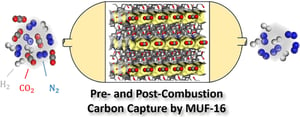 Omid T. Qazvini, Shane G. Telfer
Omid T. Qazvini, Shane G. Telfer
One of the most critical environmental issues of our age is the escalating release of CO2 into the atmosphere. Separation technologies with low energy footprints may be an effective way to capture CO2 and prevent its accumulation. Metal–organic frameworks (MOFs) can meet separation challenges due to their tailored structures and tunable pore surfaces. However, obstacles to their deployment can include the energy consumed by regeneration, a lack of long-term structural stability, and their production on large scales. Herein, we report on MUF-16 ([Co(Haip)2], H2aip = 5-aminoisophthalic acid), a hydrogen-bonded water-stable microporous material that combines high CO2 adsorption with a low affinity for other gases. MUF-16 is built up from inexpensive starting reagents in a scalable process. It can be easily regenerated at room temperature by purging with inert gas, and it maintains its performance over multiple adsorption/desorption cycles. MUF-16 features one-dimensional channels that trap CO2 guest molecules by a raft of attractive electrostatic interactions and size complementarity. It rejects H2 and N2 molecules around room temperature. This was verified by simulated and experimental breakthrough separation measurements on CO2/N2 and CO2/H2 mixtures. MUF-16 can be pelletized by coating with polymeric poly(vinylidene difluoride) (PVDF) to render it compatible with large-scale applications.
A Fluorescent Metal–Organic Framework for Food Real‐Time Visual Monitoring
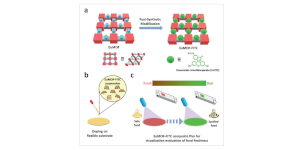 Jing Wang, Daquan Li, Yingxiang Ye, Yu Qi, Jiawei Liu, Liang Huang, Bin Liang, Banglin Chen
Jing Wang, Daquan Li, Yingxiang Ye, Yu Qi, Jiawei Liu, Liang Huang, Bin Liang, Banglin Chen
Due to increasing food‐safety issues, exploiting efficient approaches for food quality assessment and instrumentation has attracted concerns worldwide. Herein, a smart evaluation system based on a fluorescent metal–organic framework (MOF) is developed for real‐time visual monitoring of food freshness. Via post‐synthetic modification, a ratiometric fluorescent MOF probe is constructed by covalently coupling fluorescein 5‐isothiocyanate (5‐FITC) with NH2‐rich lanthanide MOF. The probes exhibit a dual‐emissive‐responsive to biogenic amine, resulting in an increase in FITC emission along with a decrease in Eu3+ emission accompanied by a clear distinguishable color transition from orange red to green. After doping the probes on a flexible substrate, the obtained MOF composite film can be integrated with a smartphone‐based portable platform easily. It is proved that this smart evaluation system can be used for on‐site inspection of the freshness of raw fish samples. This work develops a fluorescent MOF‐based smart evaluation system as a novel platform for application in food monitoring, which not only has enormous economic value but also holds great public health significance.
Intermediate Binding Control Using Metal–Organic Frameworks Enhances Electrochemical CO2 Reduction
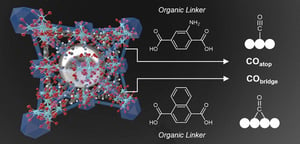 Dae-Hyun Nam, Osama Shekhah, Geonhui Lee, Arijit Mallick, Hao Jiang, Fengwang Li, Bin Chen, Joshua Wicks, Mohamed Eddaoudi*, Edward H. Sargent
Dae-Hyun Nam, Osama Shekhah, Geonhui Lee, Arijit Mallick, Hao Jiang, Fengwang Li, Bin Chen, Joshua Wicks, Mohamed Eddaoudi*, Edward H. Sargent
In the electrochemical CO2 reduction reaction (CO2RR), control over the binding of intermediates is key for tuning product selectivity and catalytic activity. Here we report the use of reticular chemistry to control the binding of CO2RR intermediates on metal catalysts encapsulated inside metal–organic frameworks (MOFs), thereby allowing us to improve CO2RR electrocatalysis. By varying systematically both the organic linker and the metal node in a face-centered cubic (fcu) MOF, we tune the adsorption of CO2, pore openness, and Lewis acidity of the MOFs. Using operando X-ray absorption spectroscopy (XAS) and in situ Raman spectroscopy, we reveal that the MOFs are stable under operating conditions and that this tuning plays the role of optimizing the *CO binding mode on the surface of Ag nanoparticles incorporated inside the MOFs with the increase of local CO2 concentration. As a result, we improve the CO selectivity from 74% for Ag/Zr-fcu-MOF-1,4-benzenedicarboxylic acid (BDC) to 94% for Ag/Zr-fcu-MOF-1,4-naphthalenedicarboxylic acid (NDC). The work offers a further avenue to utilize MOFs in the pursuit of materials design for CO2RR.
Metal-organic frameworks for advanced drug delivery
 Siyu He, Li Wu, Xue Li, Hongyu Sun, Ting Xiong, Jie Liu, Chengxi Huang, Huipeng Xu, Huimin Sun, Weidong Chen, Ruxandra Gref, Jiwen Zhang
Siyu He, Li Wu, Xue Li, Hongyu Sun, Ting Xiong, Jie Liu, Chengxi Huang, Huipeng Xu, Huimin Sun, Weidong Chen, Ruxandra Gref, Jiwen Zhang
Metal-organic frameworks (MOFs), comprised of organic ligands and metal ions/metal clusters via coordinative bonds are highly porous, crystalline materials. Their tunable porosity, chemical composition, size and shape, and easy surface functionalization make this large family more and more popular for drug delivery. There is a growing interest over the last decades in the design of engineered MOFs with controlled sizes for a variety of biomedical applications. This article presents an overall review and perspectives of MOFs-based drug delivery systems (DDSs), starting with the MOF classification adapted for DDSs based on the types of constituting metals and ligands. Then, the synthesis and characterization of MOFs for DDSs are developed, followed by the drug loading strategies, applications, biopharmaceutics and quality control. Importantly, a variety of representative applications of MOFs are detailed from a point of view of applications in pharmaceutics, diseases therapy and advanced DDSs. In particular, the biopharmaceutics and quality control of MOFs-based DDSs are summarized with critical issues to be addressed. Finally, challenges in MOFs development for DDSs are discussed, such as biostability, biosafety, biopharmaceutics and nomenclature.

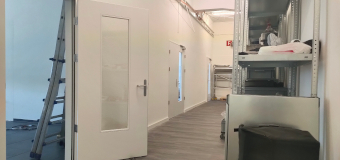






.jpg)
